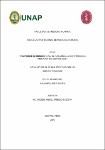Factores de riesgo para el desarrollo de pterigion primerio en Iquitos 2022
Abstract
Pterygium is one of the ophthalmological diseases that affects a large part of the population and the long-term repercussions can be permanent if not treated in time, even more so in an environment where ophthalmological health is underestimated.
PURPOSE: This research study plans to search for the main risk factors associated with the development of primary pterygium.
METHODOLOGY: It is an observational, cross-sectional and analytical study that includes 110 participants who came to the outpatient clinic of the ophthalmology service of a level III hospital in the city of Iquitos from April to July 2022. To the participants, to the leaving the outpatient clinic, they were given a questionnaire with the questions according to the study variables.
RESULTS: Of the 110 study participants, 96 of them had the disease (87.3%). In addition, male sex, age over 40 years, exposed occupation, rural residence were the most frequent sociodemographic factors. The bivariate analysis shows that the factors with significant association were place of rural origin (p = 0.004), exposed occupation (p = 0.008), level of education (p = 0.014), exposure to UV rays greater than 5 hours (p = 0.005), family history (p = 0.008), dry eye (p = 0.005), astigmatism (0.005). Crossing these results in the binary logistic regression analysis shows that family history (p = 0.049; OR = 5.831), exposure time greater than 5 hours (p = 0.031; OR = 17.902), dry eye (p = 0.026; OR = 9.713) and astigmatism (p = 0.015; OR = 15.891) were significantly associated with pterygium.
CONCLUSIONS: The main risk factors associated with the development of primary pterygium in this study are prolonged exposure to solar radiation for more than 5 hours in daily activities, history of pterygium in the family and the presence of dry eye. Astigmatism was not considered as a risk factor, but as one of the complications of the pterygium. El pterigion es una de las enfermedades oftalmológicas que afecta a gran parte de la población y las repercusiones a largo plazo pueden ser permanentes si no se trata a tiempo más aun en un medio donde la salud oftalmológica es subestimada.
PROPÓSITO: Este estudio de investigación planea buscar los principales factores de riesgo asociados al desarrollo de pterigion primario.
METODOLOGÍA: Es un estudio observacional, de corte transversal y carácter analítico que incluye a 110 participantes que llegaron a la consulta externa del servicio de oftalmología de un hospital nivel III (Seguro Social de Salud) en la ciudad de Iquitos desde abril a Julio del 2022. A los participantes, al salir de la consulta, se les otorgó un cuestionario con las preguntas de acuerdo a las variables de estudio.
RESULTADOS: De los 110 participantes del estudio, 96 de ellos presentaron la enfermedad (87,3%). Además, el sexo masculino, edad mayor a 40 años, ocupación expuesta, residencia rural fueron los factores sociodemográfico más frecuentes. El análisis bivariado muestra que los factores con asociación significativa fueron lugar de procedencia rural (p = 0,004), ocupación expuesta (p = 0,008), grado de instrucción (p = 0,014), exposición a rayos UV mayor a 5 horas (p = 0,005), antecedentes familiares (p = 0,008), ojo seco (p = 0,005), astigmatismo (0,005). Cruzar estos resultados en el análisis de regresión logística binaria se obtiene que los antecedentes familiares (p = 0,049; OR = 5,831), el tiempo de exposición mayor a 5 horas (p = 0,031; OR = 17,902), ojo seco (p = 0,026; OR = 9,713) y astigmatismo (p = 0,015; OR = 15,891) presentaron asociación significativa con pterigion.
CONCLUSIONES: Los principales factores de riesgo asociados al desarrollo de pterigion primario en este estudio son la exposición prolongada a la radiación solar por más de 5 horas en las actividades diarias, antecedente de pterigion en la familia y la presencia de ojo seco. El astigmatismo, no se consideró como factor de riesgo, sino como una de las complicaciones del pterigion.
Collections
- Tesis [368]


